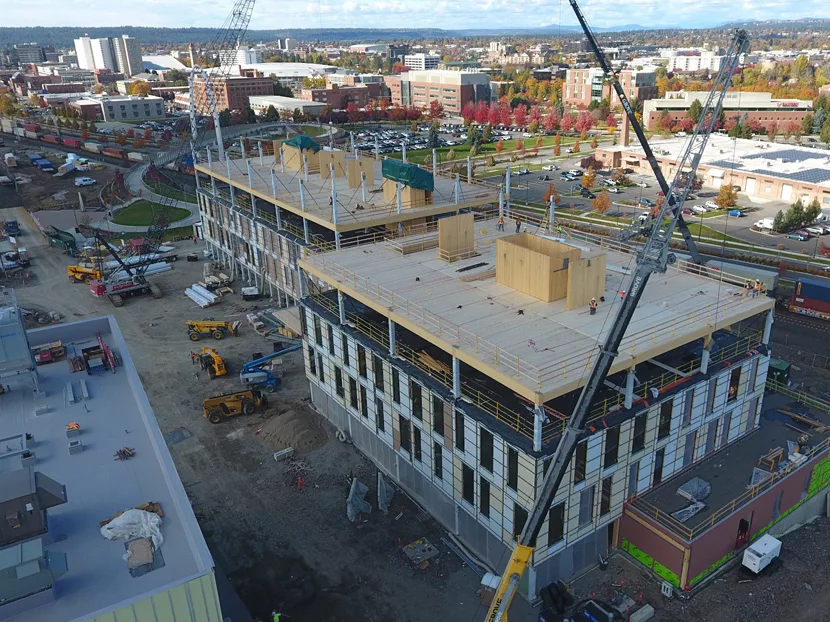Over the past 15 months, I’ve covered a range of topics and trends, including augmented reality/virtual reality (AR/VR), construction automation, supply chain optimization, the connected jobsite and smart buildings.
If there’s one takeaway, I hope it has become clear that today’s built environment is needlessly inefficient and broken. Buildings cost far too much to design, build, operate and maintain. Half of all building construction costs are wasted, as is half of all energy consumed in facility operations.
While technology is enabling us to make progress on a variety of fronts, we still have a long way to go as an industry to be more productive and less wasteful. In this regard, brighter days are ahead. What follows is a review of the trends I have discussed in recent months and where I see them headed during the next year, the next decade and beyond.
Recent trend observations
When it comes to the future of construction work, I noted that emerging AR technologies enable side-by-side work in a virtual version of the building. Teams can now pull up schematics and specifications to map out each project phase. In addition, VR offers a completely immersive and interactive three-dimensional environment that brings a project to life. This allows building owners, designers and builders to collaborate and experience the project like never before possible.
As construction automation gains momentum, fabrication shops are beginning to serve as an ideal testbed for automation with computerized programs now permeating all levels of cutters, shapers and molders. McKinstry and others are experimenting with internal software platforms designed to automate mechanical system design, detailing and fabrication. In fact, 99 percent of all carbon steel, copper and cast-iron jobs now run through some form of automated process, cutting material waste and saving as much as 40 percent from labor costs associated with fabrication.
New processes designed to optimize the supply chain, such as kitting, are helping streamline the overall flow of materials, tools and information to tradespeople on jobsites. Parts and systems are beginning to be ordered from the latest design specifications and delivered to the fabrication shop. What’s more, sensors and telematics are extending inventory management to ensure each jobsite has the tools required precisely when and where they are needed.
Jobsites are quickly becoming technology centers as manufacturers include Bluetooth sensors in all their power tools, allowing contractors to track whether these tools are at the jobsite or not. So many new technologies are emerging at jobsites that interoperability challenges exist as general, mechanical, electrical and all other specialty contractors use different tool manufacturers and tracking systems.
Lastly, technology is making our buildings smarter than ever before. Today, the building network in a modern building is as essential as mechanical and electrical systems, and integration of technology-enabled systems requires dedicated attention from schematic design. However, all these various systems, technologies and subcontractors involved force owners, operators and tenants to manage a myriad of proprietary systems.
2020 trends to watch
As you might imagine, the speed of technology adoption in fabrication shops, on the jobsite, in buildings and throughout the supply chain is only going to accelerate. Someone who worked on a jobsite 10 years ago will not recognize a site 10 or 20 years from now.
As a result of — and in response to — the ubiquity of technology in construction, I anticipate AR/VR on-the-job training systems to continue taking steps toward becoming the norm. We’re also likely to see an increasing focus on technology research and development in response to demands to increase productivity and safety.
I envision an acceleration of automation, with 3D printers using concrete and other construction materials to create structural elements for less cost. In the fabrication shop, we’ll see more measurements and cuts automated based on approved engineered drawings and schematics. In addition, expect drones to continue building on gains in novel applications such as painting, taping, mudding and constructing walls.
In response to all these industry changes, expect to see logistic transportation and supply chain begin to emerge as core business activities. Supply chain optimization will increasingly become a focus as automation and robotics redefine safety and productivity. I also would not be surprised if we start to see nontraditional competitors enter the building materials and products industry.
With the rollout of 5G and even more sensors in buildings, the connected jobsite will continue to be an area of focus in the year ahead. 5G, with its expanded capacity and support for low-power devices, will enable location-based tracking. In addition to real-time project status and budget updates, location-based tracking will make it even easier for managers to monitor jobsite safety and worker well being.
All those sensors in buildings will make predictive maintenance and automated dispatch more commonplace, creating near-autonomous operations in some building types. The demand for smart buildings will lead us to building-as-a-platform and building-as-a-service models.
We’ll also see increasing use of building technology to focus on tenant/user productivity and wellness benefits. And, we’re now entering the early days of intelligent energy management systems, including the interaction of buildings and the utility grid.
2030 and beyond
As we gaze another decade into the future, it gets a bit harder to predict industry trends, but one area where I see substantial change is a dramatic increase in “gig” or project-based work. We’ll likely see an augmented workforce emerge as workers embrace cognitive technologies, and advances in technology will require a highly adaptable, reskilled talent base.
Not surprisingly, then, we’ll see new models for acquiring and managing talent that ensure just-in-time talent (the right person for the right job at the right time). Along with this, employees will come to expect a work culture that connects to personal purpose, and one that provides flexibility and continuous learning opportunities.
A continuation of the supply chain optimization trends noted for the coming year, we’ll see building components that are premanufactured, plug-and-play modular systems become widely available. I expect this trend will result in different types of teams and partnerships forming and new business models unlocking costs, increasing speed and creating more direct access to products and services for end-users.
The pressure to compete in a digital and automated economy will force consolidation and realignment of manufacturing, distribution and construction supply chains. Looking ahead, it’s not hard to envision a time in the next decade when direct to manufacturer relationships push out distributors, while more products, particularly technology and energy products, are bought as a service.
As mind-boggling as it may be, the connected jobsite of tomorrow will look nothing like that of today. For example, contractors will be able to harness the data available from sensor-rich construction sites and use it to perform big data analytics and machine learning. These emerging capabilities will allow contractors to analyze and optimize a construction jobsite.
Finally, within the next decade, buildings will operate without onsite physical presence needed. As access to data, analytics and applications of machine learning evolve building operation capabilities, we’ll begin to transform spaces into highly connected, efficient, autonomous environments.
Technology and intelligent design will lead to a convergence of tenant wellness, productivity, smart-city, zero-carbon and equity benefits. And, in response to today’s proprietary systems, we’ll see near-ubiquity of open-source control systems.
New technologies and rising social pressures will drive the construction industry over the next year and the coming decade. Our industry’s slow call to action is failing communities, so we must act now to chart a built environment that eradicates waste and stands in balance with nature.
McKinstry is evaluating industry and technology trends and working to understand how they will impact our industry. As a result, we will continue to remain at the forefront of driving innovation in these areas and accelerating our industry to be more productive and less wasteful.






